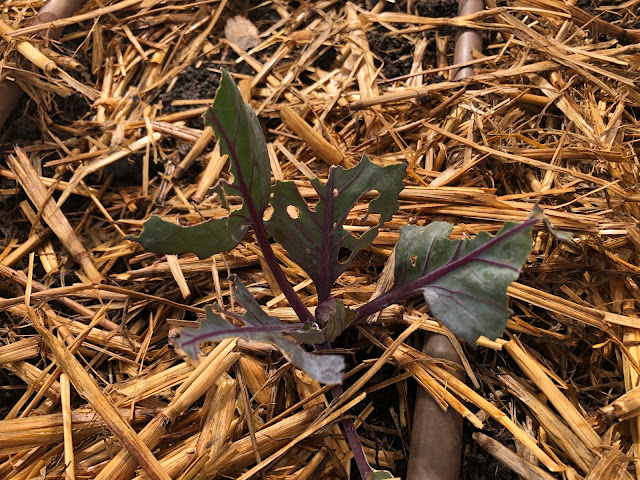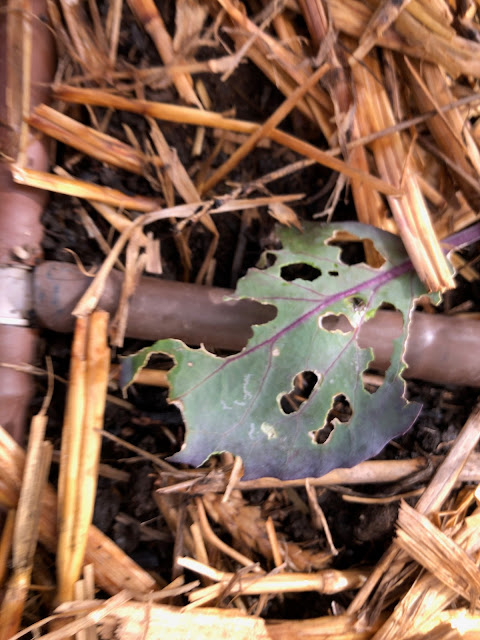
Don’t fret: It’s cooler, so things actually aren’t too bad

|
|
Most of the damage to this plant at the Fair Oaks Horticulture Center was caused by birds, says master gardener Gail Pothour. The leaves are eaten along the edges. (Photos: Kathy Morrison)
|
The oranges are splitting again. The new lettuce disappeared overnight. The carrots still aren’t sprouting. Help! Who decided that fall was an easy time to garden?
Take a deep breath. Notice the air — it’s cooler in the morning, isn’t it? Even the afternoons are better. Little spikes into the low 90s are much easier to handle than, oh, 112 degrees. Right? OK, then. Relax.
But fall does have its challenges. Here are five, and how to deal with them (or at least explain them):

|
|
Same plant as above, but a different leaf and likely different pest for most
of the damage: Caterpillars sit on the ribs and eat the leaf centers. |
Caterpillar pests crawl along the ribs of the leaves and take chunks out of the middle. At worst, they crawl down inside the heads of the developing vegetables where they can't be reached. So catch them early, if you have an outbreak. Row covers will keep the butterflies from laying eggs on the plants. Bt, short for bacillus thuringiensis, is an excellent bacteria-based caterpillar fighter.
2. Disappearing sprouts or transplants. If you see damage along the edges of the vegetable leaves, suspect birds, Pothour says. Young, fresh plants look good to them, too. Birds will sit on the soil next to the plant to feast, and can eat it down to the ground if it's young. To keep birds off the young plants, try row covers, mesh baskets or the like. Just be sure to anchor those covers so the birds can't get underneath.
3. Sprouts not appearing at all. Did you plant carrots? For such a common vegetable, they take a long time to germinate. Weeks, in fact. Be patient. Then when they do sprout and get to be about 2 inches tall, don't forget to thin them. They need space to grow. And if you're planting beets or chard, rinse the seeds first, Pothour advises. This removes a chemical on the seeds that inhibits germination. Incidentally, the master gardeners have published a great guide to growing beets .
4. Oranges splitting. This has become more of a Northern California problem in October just the past few years. It's not a disease. Basically, spikes in warm weather and lack of irrigation together signal the tree to suck some moisture out of the fruit. The fruit wall weakens. Then when the tree gets more moisture from rain or irrigation, it sends it back, bursting the weakened fruit. I wrote a full blog post on this problem last year. I've lost only two oranges to splitting so far this year, thank goodness.
5. Perennials looking ragged. Perennials tend to be leggy in late summer, and can be pruned or cut down now, especially if you see new sprouts forming at the base of the plant. Even if you don't see any, it's a good time to clean them up. Perennial herbs can use a good fall haircut, too.
Comments
0 comments have been posted.Sacramento Digs Gardening to your inbox.
Sites We Like
Garden Checklist for week of April 21
This week there’s plenty to keep gardeners busy. With no rain in the immediate forecast, remember to irrigate any new transplants.
* Weed, weed, weed! Get them before they flower and go to seed.
* April is the last chance to plant citrus trees such as dwarf orange, lemon and kumquat. These trees also look good in landscaping and provide fresh fruit in winter.
* Smell orange blossoms? Feed citrus trees with a low dose of balanced fertilizer (such as 10-10-10) during bloom to help set fruit. Keep an eye out for ants.
* Apply slow-release fertilizer to the lawn.
* Thoroughly clean debris from the bottom of outdoor ponds or fountains.
* Spring brings a flush of rapid growth, and that means your garden is really hungry. Feed shrubs and trees with a slow-release fertilizer. Or mulch with a 1-inch layer of compost.
* Azaleas and camellias looking a little yellow? If leaves are turning yellow between the veins, give them a boost with chelated iron.
* Trim dead flowers but not leaves from spring-flowering bulbs such as daffodils and tulips. Those leaves gather energy to create next year's flowers. Also, give the bulbs a fertilizer boost after bloom.
* Pinch chrysanthemums back to 12 inches for fall flowers. Cut old stems to the ground.
* Mulch around plants to conserve moisture and control weeds.
* From seed, plant beans, beets, cantaloupes, carrots, corn, cucumbers, melons, radishes and squash.
* Plant onion sets.
* In the flower garden, plant seeds for asters, cosmos, celosia, marigolds, salvia, sunflowers and zinnias.
* Transplant petunias, zinnias, geraniums and other summer bloomers.
* Plant perennials and dahlia tubers for summer bloom.
* Mid to late April is about the last chance to plant summer bulbs, such as gladiolus and tuberous begonias.
* Transplant lettuce seedlings. Choose varieties that mature quickly such as loose leaf.